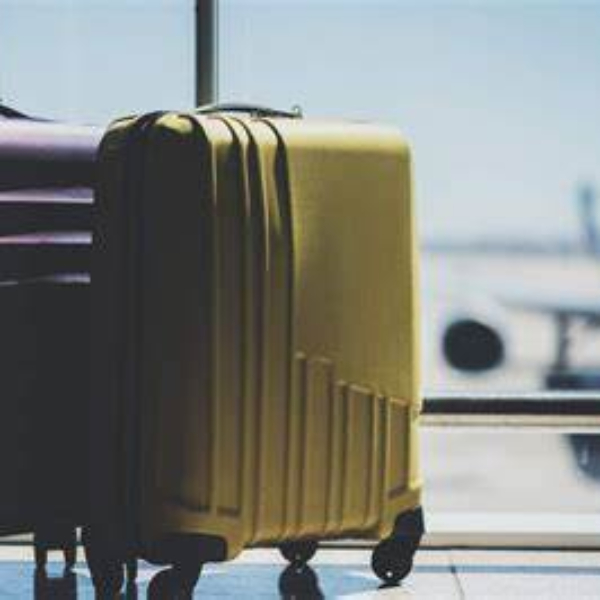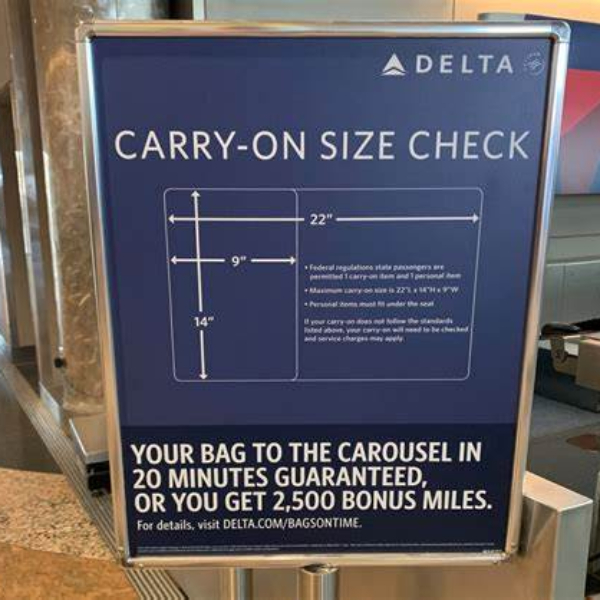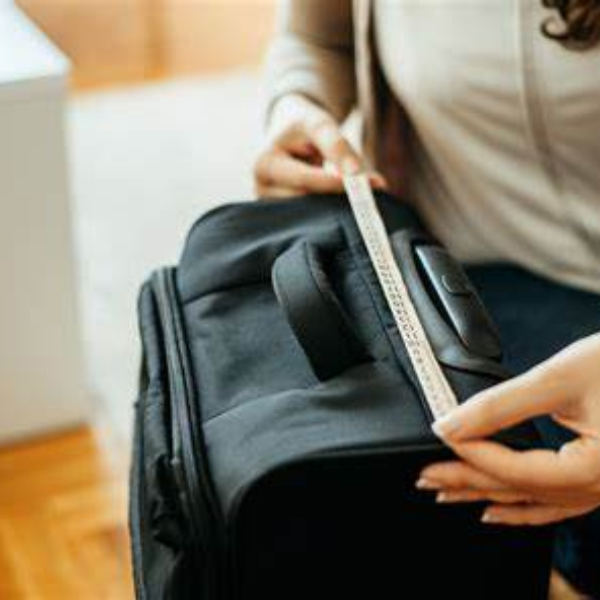Understanding Carry-On Luggage
Carry-on luggage serves as a traveler’s companion, holding essentials within arm’s reach during flights. It remains with you, stowed above your seat or beneath it, throughout your journey. Airlines each have their own policies for carry-on luggage, detailing what qualifies and what doesn’t. It’s crucial to review these policies prior to flying to avoid any airport mishaps. The Transportation Security Administration (TSA) provides a set of guidelines that travelers must adhere to as well. A stylish Hermes suitcase can elevate your travel experience while ensuring your essentials are easily accessible. Always check airline policies for specific carry-on regulations before your flight. When traveling abroad, it’s important to know the carry-on luggage international size requirements set by airlines to ensure a smooth journey. Always verify these dimensions to avoid complications at the airport.

Definition and Airline Policies
Simply put, carry-on luggage refers to bags passengers can bring into the cabin. Each airline defines what a carry-on bag means, often with specific size and weight restrictions. Full-service carriers generally allow a carry-on plus one personal item. Budget airlines might have stringent requirements or charges for carry-on baggage. Always verify airline policies beforehand to ensure compliance and avert last-minute fees.
Size and Weight Restrictions
The size and weight of a carry-on are bounded by airline regulations. Common standards for size include a combined size limit of 115cm (linear dimensions) or specified limits like 55cm x 45cm x 25cm. Weights range between 5 to 15kg. Exceed these, and you may face extra charges or have to check your bag. Double-check your bag meets airline stipulations before heading to the airport. Remember, conforming to these limits helps secure your carry-on’s spot on the plane. When planning a carnival cruise carry-on, ensure it complies with size and weight regulations. This will help avoid extra charges and guarantee your bag fits on board.
Acceptable Carry-On Items
What goes into your carry-on is governed by safety protocols. Standard rules prohibit liquids over 100ml, sharp objects, and flammable substances. Pack smart by including necessary travel comforts like headphones, a phone charger, and a good read. Valuables and fragile items should always go in your carry-on, ensuring they stay safe and under your watch. Adhering to the TSA and airline policies guarantees a trouble-free security check and peace of mind throughout your flight.
Packing Your Carry-On Wisely
Packing a carry-on requires thoughtfulness and a strategic approach. Choose items that maximize comfort and minimize hassle during your flight. Keep your carry-on light to ease movement through the airport. A Louis Vuitton travel bag combines style and functionality, making it perfect for carrying essential items. Its lightweight design ensures easy maneuverability through the airport.
Must-Have Travel Essentials
Every traveler’s carry-on should include several key items:
- Identification and travel documents, like a passport and boarding passes.
- Electronic devices such as a smartphone, tablet, or e-reader to stay entertained.
- Chargers or power banks to keep devices powered up.
- A travel pillow and eye mask for comfort on long flights.
- Snacks or a water bottle (empty to refilling after security).
- Any required medications, with prescription labels.
- A lightweight change of clothes for freshening up or in case of spills.
These essentials ensure that you have what you need within reach, enhancing your travel experience.

Organizing for Security Checks
When packing, consider security checks:
- Use clear, resealable bags for small liquids and gels.
- Place electronics in an easily accessible part of your carry-on.
- Wear shoes and belts that you can quickly remove if required.
- Apparel with fewer metal accessories reduces time at security.
Good organization helps you pass through security checks faster, with fewer hold-ups.
Balancing Convenience with Airline Regulations
When packing your carry-on, adhere to airline policies:
- Check your airline’s size and weight limits for carry-on luggage.
- Familiarize yourself with restricted items list and pack accordingly.
- Consider the practicality of items packed versus their necessity.
- Remember that some items may be purchased or provided at your destination.
Following regulations and packing only necessities will help avoid extra fees and ensure a smoother journey.
Choosing the Right Carry-On Bag
Choosing the right carry-on bag can make your travels smoother and more pleasant. It’s not simply about style; features, durability, and airline compliance matter greatly. When selecting carry-on luggage, be sure to check the international size regulations. A well-sized bag ensures compliance and enhances your travel experience.
Features of a Good Carry-On
When hunting for that perfect carry-on bag, aim for these features:
- Lightweight construction to avoid adding extra weight.
- Strong, durable materials to withstand travel rigors.
- Wheels for easy maneuverability through airports.
- Compliant dimensions to fit in overhead bins or under seats.
- Multiple compartments for organized packing.
Remember, a good carry-on bag should make travel easier, not more complicated.
Comparing Different Types of Carry-On Luggage
There are various types of carry-on luggage:
- Hardshell suitcases, perfect for protecting valuables.
- Soft bags, offering more flexibility for squeezing into tight spaces.
- Backpacks, great for hands-free movement.
- Underseat luggage, ideal for those prioritizing accessibility.
Compare these based on your travel needs to pick the right one.
Recommended Carry-On Bags for Travelers
For hassle-free travel, here are some top carry-on choices:
- The Cabinzero Classic 28L, known for its robust build.
- The Samsonite Winfield 2, with hardshell protection.
- A versatile backpack like the Osprey Farpoint 40, designed for comfort.
These bags meet airline standards and cater to various travel needs, ensuring you’re ready for your next adventure.
Personal Items vs. Carry-On Bags
Navigating the nuances between personal items and carry-on bags is vital for stress-free travel. Airlines often allow both, but each has distinct rules and purposes.
Differentiating Between the Two
Personal items are smaller than carry-on bags and must fit under the seat. These include handbags, small backpacks, or laptop cases. Carry-on bags are larger and stored in the overhead bin during a flight. They are typically wheeled suitcases or larger backpacks. When traveling internationally, ensure your carry-on luggage meets size requirements for overhead bins. Personal items, like small backpacks, should fit comfortably under the seat.
Packing Tips for Personal Items
When packing a personal item, prioritize items you’ll need in-flight. Include travel documents, medications, and electronics. Pack items like a book or headphones for comfort. Remember, this bag should be lightweight and easy to access under the seat.
Maximizing Your Personal Item Capacity

Choose a personal item with multiple compartments to make the most of the space. Roll clothing items to fit more and use small bags or cases to organize accessories and cords. Check airline policies for size limits to ensure your personal item fits their criteria. When packing for international travel, choose a personal item that fits airline carry-on luggage size regulations. Organized compartments help maximize space for your clothing and accessories.
Travel Tips for Carry-On Only Trips
Traveling with only a carry-on can simplify your journey. Plan smartly to avoid hold-ups and enjoy flexibility.
How to Travel Lightly and Efficiently
- Choose versatile clothing that mixes and matches well.
- Wear your bulkiest items, like jackets or boots, to save space.
- Use packing cubes or compression bags to organize and compress items.
- List what you need before packing to avoid overstuffing your bag.
- Check weather forecasts for your destination to pack appropriate attire.
- Opt for travel-sized toiletries and containers compliant with TSA guidelines.
Strategies for a Hassle-Free Flight
- Arrive early at the airport to navigate security with ease.
- Keep your ID, boarding pass, and travel documents in an accessible spot.
- Dress in layers to adjust to changing cabin temperatures.
- Stay hydrated and avoid alcohol to feel your best during the flight.
- Download entertainment, like movies or books, on your devices beforehand.
- Charge all electronics fully before leaving for the airport and carry a power bank.
What to Keep Accessible During the Flight
- Store your travel pillow and eye mask at the top of your bag.
- Keep snacks and a refillable water bottle handy.
- Have a small toiletry bag with essentials like hand sanitizer and lip balm.
- Place headphones or earplugs within easy reach to block out cabin noise.
- Pack a lightweight jacket or scarf for extra warmth if needed.
Following these tips can make traveling with just a carry-on bag a breeze. Plan well, pack smart, and enjoy the comfort of having all you need with you.
Overcoming Common Carry-On Challenges
Carrying only a carry-on can be tough, but not impossible. Overcoming common challenges will make your journey smoother.
Dealing with Limited Space
Limited space means choosing what to bring wisely. Roll clothes to save room. Use packing cubes for organization. Wear bulky items like coats. Pack multi-purpose garments and travel-size toiletries. Stick to the essentials and remember, less is more. When packing for international travel, choose wisely for your carry-on luggage to meet international size requirements. Remember to roll clothes and pack multi-purpose items for efficiency.
The TSA liquids rule can be tricky. Remember, all liquids must be 100ml or less. Put them in a clear, quart-sized bag. Keep it accessible for security. Avoid carrying liquids unless necessary. Use solid alternatives for toiletries when possible.
Managing Electronics and Battery Regulations
Electronics are essential, but they have rules. Batteries must be in carry-on, not checked bags. Power banks count too. Spare batteries should be in original packaging. Cover loose battery terminals with tape. Keep electronics in an easy-to-reach spot for screening. Check airline electronics policies before heading to the airport. When traveling internationally, ensure your electronics fit within carry-on luggage international size restrictions. Keep batteries and power banks accessible for smooth security screening.